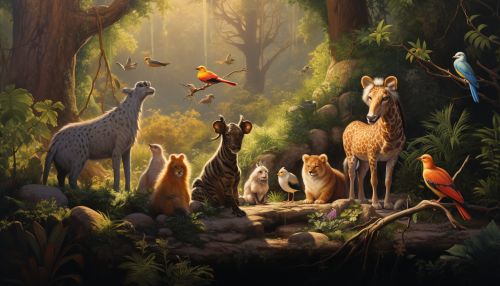The Science of Animal Social Networks and Collective Behavior
Introduction
The science of animal social networks and collective behavior is a growing field within ethology, the study of animal behavior. This discipline seeks to understand the complex social structures and behaviors exhibited by various animal species, from insects to mammals, and how these behaviors contribute to their survival and evolution.


Animal Social Networks
Animal social networks are the intricate web of interactions and relationships between individuals within a species. These networks can be analyzed using social network analysis, a method originally developed for studying human social interactions.
Structure of Animal Social Networks
Animal social networks can vary greatly in structure, depending on the species and the environment. Some species form highly structured, hierarchical networks, while others have more egalitarian social structures. The structure of these networks can have significant impacts on the survival and reproduction of individuals within the network.
Influence of Social Networks on Animal Behavior
Social networks can greatly influence animal behavior. For instance, information about food sources or predators can quickly spread through a network, influencing the behavior of many individuals. Social networks can also influence mating behavior, with individuals often preferring to mate with those they are closely connected to in the network.
Collective Behavior in Animals
Collective behavior in animals refers to the coordinated behavior of groups of animals. This can range from the synchronized movement of a school of fish, to the complex division of labor in an ant colony, to the coordinated hunting strategies of a pack of wolves.
Types of Collective Behavior
There are many types of collective behavior in animals, including:
- Flocking: This is the behavior exhibited by birds, fish, and some mammals where they move in a coordinated manner. This behavior can help protect individuals from predators and can also aid in finding food.
- Swarming: This is a behavior exhibited by insects and some birds where a large group moves together. This can be for a variety of reasons, including mating, finding food, or migrating.
- Herding: This is a behavior exhibited by many mammals where they move and live in groups. This behavior can provide protection from predators and can also aid in finding food.
- Eusocial behavior: This is a behavior exhibited by some insects, such as ants, bees, and termites, where there is a division of labor within the group. This behavior can allow for more efficient use of resources and can also aid in the survival of the group.
Mechanisms of Collective Behavior
The mechanisms that drive collective behavior in animals are still not fully understood. However, it is believed that these behaviors are driven by a combination of genetic predispositions, learned behaviors, and environmental influences.
Impact of Social Networks and Collective Behavior on Animal Survival and Evolution
The social networks and collective behaviors of animals can have significant impacts on their survival and evolution. For instance, animals that are well-connected within their social network may have better access to resources and mates, increasing their chances of survival and reproduction. Similarly, collective behaviors such as flocking or swarming can provide protection from predators, increasing the survival chances of individuals within the group.
